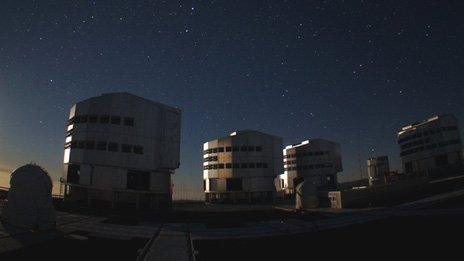Super-chilled robot ready to slice and dice
- Published
- comments
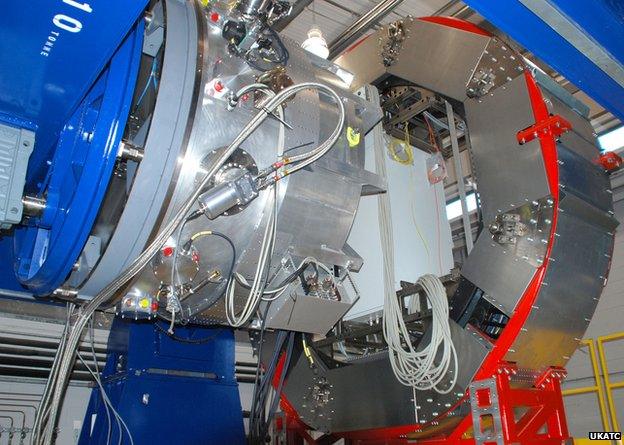
KMOS comprises the instrument (L) and its cable wheel (R), which also houses a lot of electronics
Have you noticed how the really big outstanding questions in science today seem to need a big machine to answer them?
KMOS certainly falls into that category, although what this 8.5 tonne behemoth does is not immediately obvious when you first lay eyes on it.
It hums and hisses, and slowly twists. But this is as close as you'll get to a time machine.
The K-band Multi-Object Spectrograph, external is to be fitted to the Very Large Telescope at the Paranal Observatory, external in Chile.
It will study light that's been travelling through space for more than 13 billion years. Its quest will be to identify the first objects to shine in the Universe - the very first stars and galaxies.
KMOS will work out the precise distances to these objects and tease out details of their construction.
The £15m instrument has just completed its assembly at the UK Astronomy Technology Centre (UKATC), external in Edinburgh and is now ready to ship to South America for installation on the VLT Unit 1 telescope (aka Antu), external.
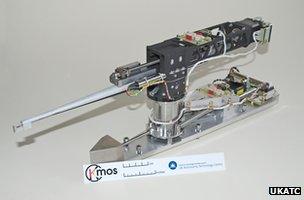
Like a dentist pushes a mirror into the mouth, KMOS pushes a mirror into the field of view
It has been a major British project (investment: £7.5m) but has called on the talents of institutions and companies right across Europe.
Spectrographs in astronomy are nothing new. However, there are high expectations that the speed and precision of this "super-chilled robot" will make some startling discoveries.
Here is how it will work.
KMOS will be bolted to the side of Antu, a telescope which has a primary collecting surface that is 8.2m wide and thus one of the best facilities of its kind in the world.
Antu will gather up the faintest starlight and send it into the spectrograph's field of view.
Michele Cirasuolo: 'A chunky machine to study the distant Universe'
Inside the instrument is a ring of 24 mechanical arms, each of which holds a small gold-plated mirror at its end - the hi-tech equivalent of the sort of thing a dentist might stick in your mouth.
KMOS manoeuvres these arms across the field of view and into the light paths of specific far-flung galaxies.
These light signals are then bounced even deeper inside the machine, and, with the aid of more than 1,500 other mini-mirrors, are sliced and diced to reveal their component colours - their spectra.
Whereas previous generations of spectrographs might have returned averaged information across a single object, KMOS will churn out detailed data from multiple regions within a single galaxy source.
It should be transformative.
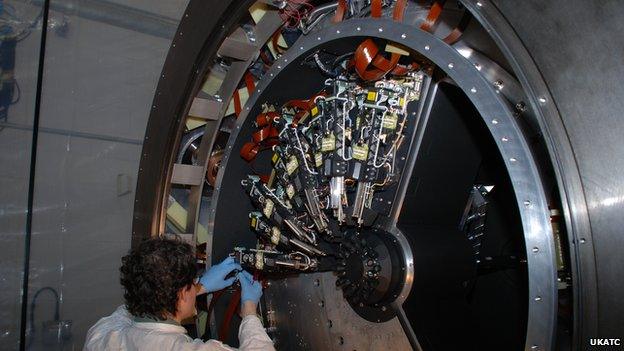
The robotic arms must continue to function at 100 kelvin (minus 173C)
"For each of the galaxies, you get the physics and the chemistry and the dynamics. This is called 3D spectroscopy," says Dr Michele Cirasuolo from UKATC.
"Until now, this approach has been done for one object at a time, which is really time-consuming and painful. You can imagine that if you want to do this for a big number of galaxies to get good statistics - that takes years.
"This is why KMOS is important; it is opening this window in a proper statistical way.
"The VLT already has an instrument called SINFONI, external, which has done something similar but, as I say, just one object at a time. In five or six years of operation, SINFONI has observed 150-200 objects. KMOS is going to do that in a couple of months."

The VLT is able to link its four units together to create a huge virtual telescope with a much better zoom
I called KMOS a super-chilled robot because it will operate at fantastically low temperatures.
To see the first objects to shine in the Universe, you must look in the infrared (KMOS is sensitive across wavelengths of light ranging from 0.8 to 2.5 microns).
That is problematic for any instrument because unless it cools its systems, the heat energy from its own components will swamp the very signal it is chasing.
The entire robotic assembly within KMOS will be plunged to minus 173 Celsius (100 kelvin) with the aid of liquid nitrogen. The instrument's detectors work best at even lower temperatures and they will be dropped to minus 233 Celsius (40 kelvin).
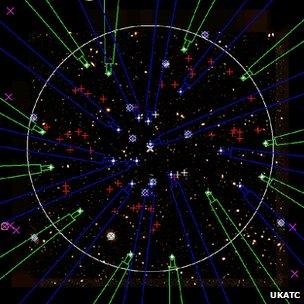
Each arm's gold-plated mirror will pick out a specific galaxy in the field of view
Think about that for a moment; consider the engineering challenge of getting moving parts to work reliably at such low temperatures.
"Most people would say 'just don't do it; it's too difficult and it's too risky'," says Phil Rees, the UKATC systems engineer on KMOS.
"Because the instrument is running at 100K, you cannot lubricate any mechanism.
"Any known lubricant would freeze solid or become glue-like. So everything has to be unlubricated.
"Also, you have to be extremely careful because different materials will shrink at different rates as they go cold.
"We asked industry whether they could make our cryogenic mechanisms and they came back to us after a year and said they couldn't do it.
"But we've done it. We bought in all the components and qualified them ourselves. Our robotic arms work."
And that twisting movement? At first you wonder why, and then it is explained that the telescope must swivel as it tracks objects on the sky, and that means the instrument has also to rotate if it wants to keep a lock on those same galaxies.
Phil Rees: 'The whole instrument has to be able to rotate through 360 degrees'
I have written quite a bit recently about the quest to see the first stars and galaxies.
Scientists are impatient to probe this epoch because they will learn how the early Universe evolved, and that will help them explain why the cosmos looks the way it does now.
The first stars were likely hot, blue giants. They would have burnt brilliant but brief lives, producing the very first heavy elements. And their intense ultra-violet light would have transformed their environment, "frying" the neutral gas around them - ripping electrons off atoms - to produce the diffuse intergalactic plasma we still detect between nearby stars today. It is certainly a key epoch.
I posted recently on the James Webb Space Telescope, and its Miri instrument, which the UKATC also had a hand in developing. JWST is being tuned specifically to see this ancient cosmic period. But JWST is six years away from launch, and until it gets into orbit we must use the tools currently available.
KMOS is now centre-stage.
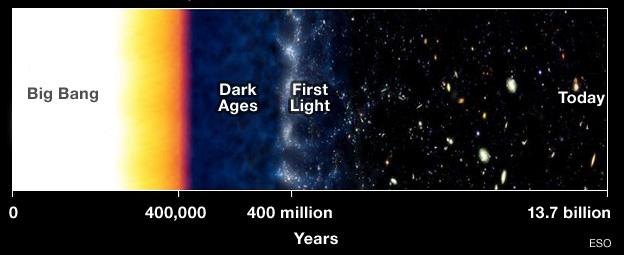
Period before the first stars switch on is known as the 'Dark Ages'
Cosmos at this stage is dominated by neutral hydrogen gas
First stars forge the first heavy elements and 'fry' the gas around them
Epoch of 'First Light' is a key epoch for cosmic evolution
- Published11 June 2012
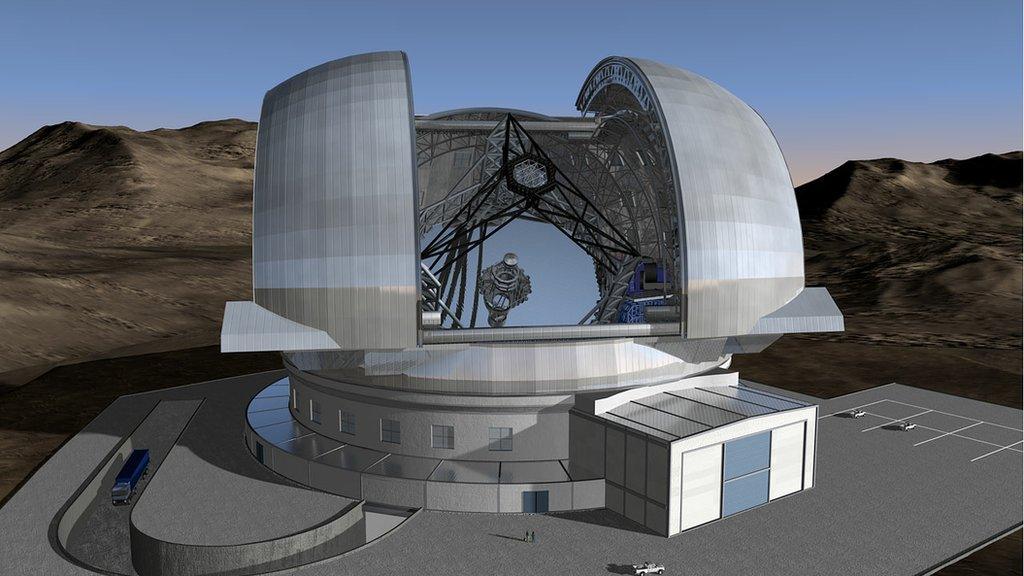
- Published11 June 2012
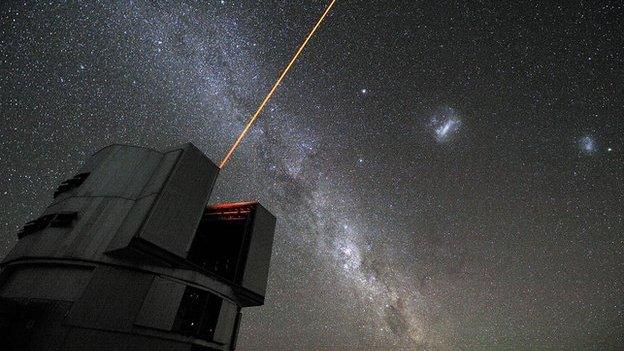
- Published28 March 2012
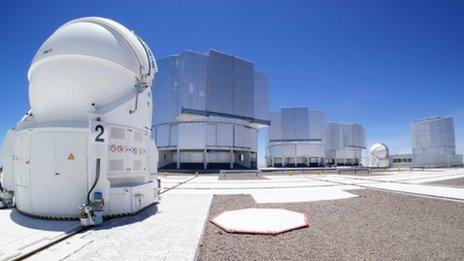
- Published8 February 2012
- Published3 February 2012
